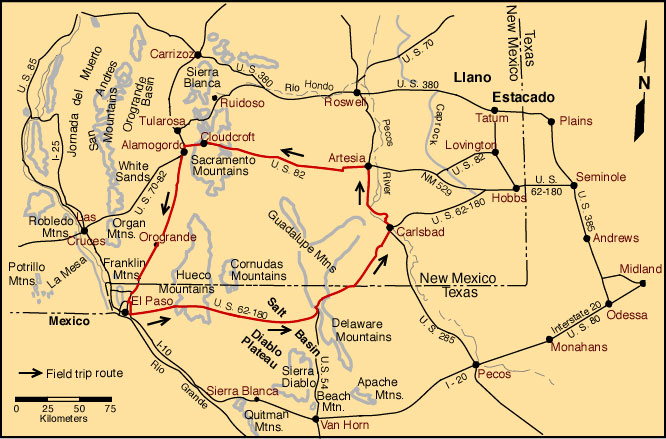
Virtual Geologic Field Trips to the Permian Reef Complex, Guadalupe and Delaware Mountains, New Mexico & West Texas
— Geologic Road Log: Walnut Canyon (Carlsbad Caverns National Park)
Stops:

Introduction
This guide to the geology along NM Hwy. 7 from Whites City to Carlsbad Caverns (Walnut Canyon) was put together for AAPG Field Seminars run from the 1980's through the mid-1990's. Some elements have been revised since then; others are in the process of being revised. So please accept the fact that not all parts of this log are fully up-to-date. Clicking on references shown in blue takes you to the appropriate bibliography; however, you may need to scroll to the correct citation. The descriptions of the main field trip localities also are found in separate files but are easily accessed by clicking on the locality name. This is a side trip from the main field trip roadlog to U.S. 62-180 from El Paso to Carlsbad.
| Mileage | Cumul. Mileage | Location Description |
|---|---|---|
| 0.0 | 0.0 |
Junction with U. S. Highway 62-180 and New Mexico Highway 7 in Whites City, New Mexico at mileage 141.3 (reverse mileage 18.1) on El Paso-Carlsbad roadlog. Take NM Highway 7 toward Carlsbad Caverns. |
| 0.5 | 0.5 |
STOP I-2. Capitan reef to back-reef transition at mouth of Walnut Canyon. Click on stop name to see locality description. This stop is partially on National Park land and partly on private land. Collecting is not permitted within Carlsbad Caverns National Park and you should get permission to access the eastern part of the outcrop which is privately owned. |
| 0.2 | 0.7 |
Near-back-reef Mizzia-dominated grainstones on right which we have examined in our previous traverse. |
| 0.2 | 0.9 |
Cross Walnut Canyon. |
| 0.2 | 1.1 |
Pisolite-bearing dolomites and faulted upper Yates sandstones in roadcut. |
| 0.1 | 1.2 |
Upper Yates and lower Tansill sediments in canyon walls. This locality exposes mainly pisolitic dolomites and sandstones and is an excellent area of examining tepee structures. |
| 1.0 | 2.2 |
Exhibit area on right. |
| 0.3 | 2.5 |
Roadcuts on right expose Yates Fm. dolomite and sandstone. |
| 1.0 | 3.5 |
Parking area on left with exposures of pisolitic dolomites, tepee structures, and sandstones of Yates Fm. |
| 0.5 | 4.0 |
Exhibit area (showing botanical diversity of the area) on the left. Canyon wall on left has exposures of Yates Fm., including the large, sand-filled cavern described by Dunham (1972, Stop II-5). |
| 1.25 | 5.25 |
Sharp bend in road; primitive road on right can be used as parking area to view exposures of Yates Fm. just ahead. |
| 0.05 | 5.3 |
STOP I-4. Hairpin Turn pisolite locality. Click on stop name to see locality description. Please remember that you are in the National Park and collecting of any kind is not permitted. |
| 0.3 | 5.6 |
Exhibit area on left; the thin sandstone-siltstone unit which marks the Tansill-Yates contact is exposed on the left. The road ascends into Tansill Fm. dolomites. |
| 1.9 | 7.5 |
STOP I-3. Carlsbad Caverns entrance parking lot. Click on stop name to see locality description. Please remember that you are in the National Park and collecting of any kind is not permitted. |



